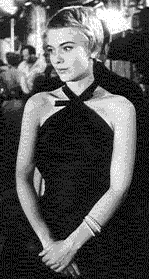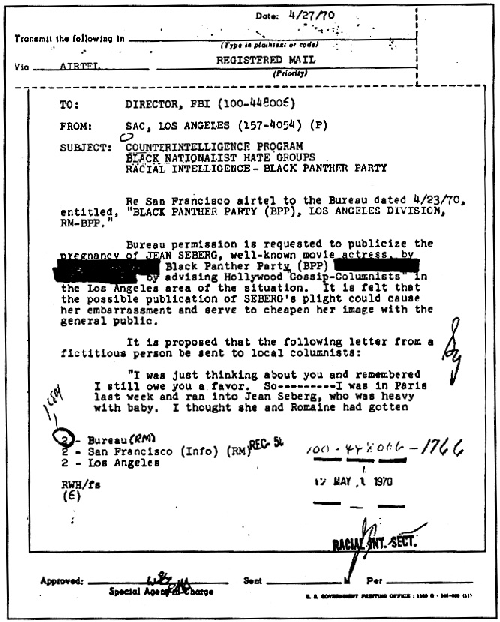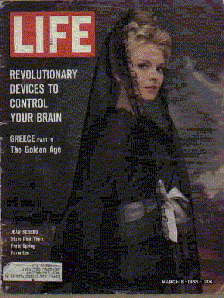Mag sich da jede(r) selbst einen Reim drauf machen, ich zitiere noch aus einigen Besprechungen im WWW über MARK RAPPAPORT's From the Journals of JEAN SEBERG.
From the Journals of JEAN SEBERG draws parallels between SEBERG, JANE FONDA, and VANESSA REDGRAVE. All were political activists -- FONDA against Vietnam, REDGRAVE for the PLO, and SEBERG for the Black Panthers (an affiliation for which she was hounded by J. EDGAR HOOVER and the FBI). All were connected, in one way or another, by their husbands, lovers, or previous directors. At times, this parallelism seems forced, but it leads to a number of interesting observations about FONDA and REDGRAVE.
Despite generous heapings of gossip and indisputable fact, the most interesting aspect of JEAN SEBERG may be the film criticism. RAPPAPORT thoroughly dissects at least five of SEBERG's films (Joan of Arc, Bonjour Tristesse, Breathless, Lilith, and Birds in Peru), offering commentary of the depth and insight that is typically found in only the most exhaustive critical essays. RAPPAPORT also offers an opinion of what made SEBERG unique -- according to him, she was the first actor to stare blankly back at the camera.
From the Journals of JEAN SEBERG. A Film Review by JAMES BERATDINELLI
Never less than entertaining, often witty, even enlightening, this is still a manipulative, distorting, tendentious film. Purporting to be a documentary investigation into the life of JEAN SEBERG, the publicly humiliated star of two notorious Hollywood flops, who achieved immortality as the American newspaper-vendor in GODARD’s À BOUT DE SOUFFLE, and was hounded by J. EDGAR HOOVER for her involvement with the Black Panthers (and daring to have a black lover!), before committing suicide after umpteen attempts, not to be discovered rotting in a car for ten days; FROM THE JOURNALS OF JEAN SEBERG is actually a piece of film criticism, a denunciation of male-propagated cinema, both commercial and critical, a cinema concerned only with containing, humiliating and eventually destroying women.
From the Journals of JEAN SEBERG. A Film Review by DARRAGH O’DONOGHUE
In "From The Journals Of JEAN SEBERG", MARK RAPPAPORT's fictitious approach to her life, a former babysitting charge who grew up around the corner from SEBERG tells the story of a sensitive small town girl driven to professional and personal despair. MARY BETH HURT, now 47, plays the JEAN SEBERG who might have been had she overcome the tragedy of her life with RAPPAPORT's blessed sense of irony. The film traces the work of such contemporaries as JANE FONDA and VANESSA REDGRAVE who achieved greater fame and recognition than SEBERGand were better protected emotionally during their days of political activism.
The fragile SEBERG tried to kill herself annually on the anniversary of her baby daughter's death, after being hounded by the FBI who leaked false rumours that the premature infant had been fathered by a Black Panther. In "From The Journals of JEAN SEBERG", now playing at art houses across the country, RAPPAPORT tells an immensely sad story with both effective detail and compassionate honesty.
"Movie Magazine International" Tribute Copyright 1996 MONICA SULLIVAN
JEAN SEBERG was always more icon than actress. From her disastrous appearance as the title character in PREMINGER's Saint Joan (1958), to GODARD's immortalizing of her face in Breathless, to her status as fashion maven in the 1960s, to her extracurricular work with the Black Panthers, SEBERG's acting career seemed secondary to her cultural presence from the beginning. Her transition from prestige pictures like Bonjour Tristesse to Eurotrash epics like her husband ROMAIN GARY's Birds in Peru and empty-headed blockbusters like Airport did nothing to alter the public perception of SEBERG as a beautiful, troubled, "empty vessel" into which various men and male groups — the sadistic PREMINGER, GODARD, novelist ROMAIN GARY, the Panthers — poured their often misogynist obsessions.
...SEBERG's career was filled with disappointments — good roles that flopped at the box office (Lilith) and bad roles that succeeded (Airport). Her personal relationships were equally disappointing, but particularly with ROMAIN GARY, whose female characters, she tells us, were invariably whores and nymphomaniacs. This revelation is part of a striking sequence that links her with JANE FONDA and VANESSA REDGRAVE. RAPPAPORT explores issues of sexism, fetishism, and exploitation in this troika — FONDA's marriage to VADIM resulting in fetish fantasies like Barbarella, REDGRAVE suffering (if not quite so vividly) at the hands of TONY RICHARDSON, and of course SEBERG enacting her husband's lurid, sexist fantasies in a string of films. SEBERG, speaking through HURT, wonders why so many writers and directors insist on offering images of their wives as hookers and femme fatales.
"From the Journals of JEAN SEBERG" A film review by GARY MORRIS
"From the Journals of JEAN SEBERG"
A film review by LINDA LOPEZ MCALISTER on "The Women's Show" WMNF-FM (88.5), Tampa, FL May 4, 1996
I'm in Philadelphia this weekend and am looking forward to seeing some of the entries by women filmmakers in the Philadelphia International Film Festival that's in full sway. Yesterday, however, I went to see a film that's not part of the festival but struck me as one of the most fascinating and original films I've seen in a long time. It's called quot;From the Journals of JEAN SEBERG" and was written and directed by MARK RAPPAPORT. I gather that what struck me as so original, the idea of doing a fictional documentary, RAPPAPORT has done before in his earlier "Rock Hudson's Home Movies." That one sounded like a pure exploitation flick so I didn't go see it, but I may have to track it down now to see if it's as insightful as this JEAN SEBERG sequel. What RAPPAPORT does is imagine that actor JEAN SEBERG, who burst upon the world's consciousness in 1957 when she was selected by OTTO PREMINGER to play the lead in his filming of "St. Joan," has kept a journal all these years--form 1957 until now, even though she committed suicide in 1978 at age 40. And what he puts on film is JEAN SEBERG (as she would appear in 1996 had she lived) looking back and commenting on her life and death, on what it was like to be a woman movie star in the '50s, '60s and '70s. He uses the lives and careers of two of her contemporaries, JANE FONDA and VANESSA REDGRAVE as points of comparison. They are particularly apt choices since they, like SEBERG, both starred in films made by their director husbands, and were later outspokenly active in leftist political "causes" that won them the ire of the general public. MARY BETH HURT plays JEAN SEBERG and tells her story, interspersed with miles of film footage from SEBERG's and other films. HURT is immensely credible as SEBERG; we can really believe that this is what she mighthave looked like if she hadn't died. Coincidentally, HURT also hails from Marshalltown, Iowa where SEBERG was discovered, and studied with the same high school drama teacher. JEAN SEBERG's instant celebrity in 1957 came crashing down about her ears in 1958 when the disastrous "Saint Joan" came out. Publicity hound PREMINGER got a lot of press from his talent hunt and his idea to cast an actor of the same age of Joan of Arc, but, as the fictionalized JEAN says of her young girlish image on the screen: who would follow that cheerleader into battle? Let's just say she wasn't quite up to the role. Rather than going back to Iowa in disgrace, SEBERG was cast next in the film version of FRANÇOISE SAGAN's "Bonjour Tristesse" and then by JEAN-LUC GODARD as the young American woman in his film "Breathless." Here began her trademark returning the gaze of the camera, though it seems more the vacant stare of an actor who isn't doing anything than a conscious subversion of film codes. JEAN SEBERG did have one of those faces that the camera loves and the French seemed to like her a lot, she remained in Paris, marrying first a young actor/filmmaker and later the much older novelist ROMAIN GARY, He,then, began writing and then directing films all of which seemed to feature a younger wife and an older husband with highly missogynistic themes. The older, wiser, SEBERG/HURT points out how at that point neither SEBERG nor FONDA nor REDGRAVE would have even uttered the word "feminism" or known what it meant had they heard it. They were, instead, intent on playing whatever nymphomaniac, whore, or space bimbo their respective husbands at the time, chose to show off to the ogling eyes of the male public. What with JEAN SEBERG's return to American and her involvement with the Black Panther Party in the 1960s and '70s, she earned the rage of J. EDGAR HOOVER and the FBI, who apparently started rumors about her and engaged in all sorts of chicanery to discredit her. After the death of a premature baby JEAN SEBERG attempted suicide and continued to do so every year on the anniversary of the baby's death. In 1978 she succeeded. I want this film to show to my Women and Film class. I've never seen anything quite like it for galvanizing attention on the way women are exploited--and eagerly conspire in their own exploitation--in the film industry. Only once or twice in the last five years have I put a film by a male filmmaker on my annual 10 best feminist films list, but I think MARK RAPPAPORT is going to make it this year. I don't know when or if it's coming to Tampa, but I'm sure it will be out on video at some point. So make a mental note to go see "From the Journals of JEAN SEBERG" for the feminist film history you don't get in the film history books.
For the WMNF Women's Show this is LINDA LOPEZ MCALISTER on Women and Film.
Weitere Links möchte ich hier nicht aufführen, da ich zwar noch mehr gelesen habe, vor allem Besprechungen RAPPAPORTs, aber nichts besseres gefunden habe. Die Zahl der Besprechungen im WWW dürfte aber noch zunehmen. Hoffentlich kommen auch noch welche des DUBINI-Films hinzu.






